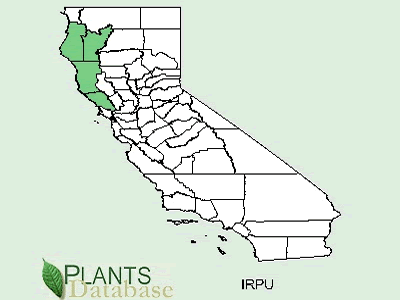Our Native Irises: Pacific Coast Irises
Iris purdyi: Purdy's Iris
Purdy’s iris occurs in northern California’s coastal ranges between Sonoma and Trinity counties.
 Purdy’s iris displaying a creamy white color with a darker yellow signal and pale violet veins. Photo © Kenneth Walker, courtesy Society for Pacific Coast Native Iris.
Purdy’s iris displaying a creamy white color with a darker yellow signal and pale violet veins. Photo © Kenneth Walker, courtesy Society for Pacific Coast Native Iris.
Iris purdyi flowers range from creamy yellow to white or to a patina of lavender. The sepals are widely spreading, flattish with reddish brown to purple prominent veins. The petals are widely spreading, flattish, and similar in coloration to the sepals. The inflorescence has one or two flowers. The flowering stalk is shorter than the attending leaves. The few leaves are dark green to gray-green, basal intense pink to dark red spots on the base, and upright to slightly flexing, from branching rhizomes with fibrous roots occurring as dense clumps.
 Note how the venation on the sepals is very pale until they cross the yellow signal becoming more prominent so as to direct pollinators to the nectarines of the flower. Photo © Kenneth Walker, courtesy Society for Pacific Coast Native Iris.
Note how the venation on the sepals is very pale until they cross the yellow signal becoming more prominent so as to direct pollinators to the nectarines of the flower. Photo © Kenneth Walker, courtesy Society for Pacific Coast Native Iris.
 The violet venation is very prominent on this Purdy’s iris, providing direction to the nectaries for potential pollinators. Photo © Collin Rigby, courtesy Society for Pacific Coast Native Iris.
The violet venation is very prominent on this Purdy’s iris, providing direction to the nectaries for potential pollinators. Photo © Collin Rigby, courtesy Society for Pacific Coast Native Iris.
Iris purdyi is found growing in moderately shady mixed hardwood and evergreen forests.
For More Information
 A small population of Purdy’s iris in a woodland opening. Photo © Collin Rigby, courtesy Society for Pacific Coast Native Iris.
A small population of Purdy’s iris in a woodland opening. Photo © Collin Rigby, courtesy Society for Pacific Coast Native Iris.


